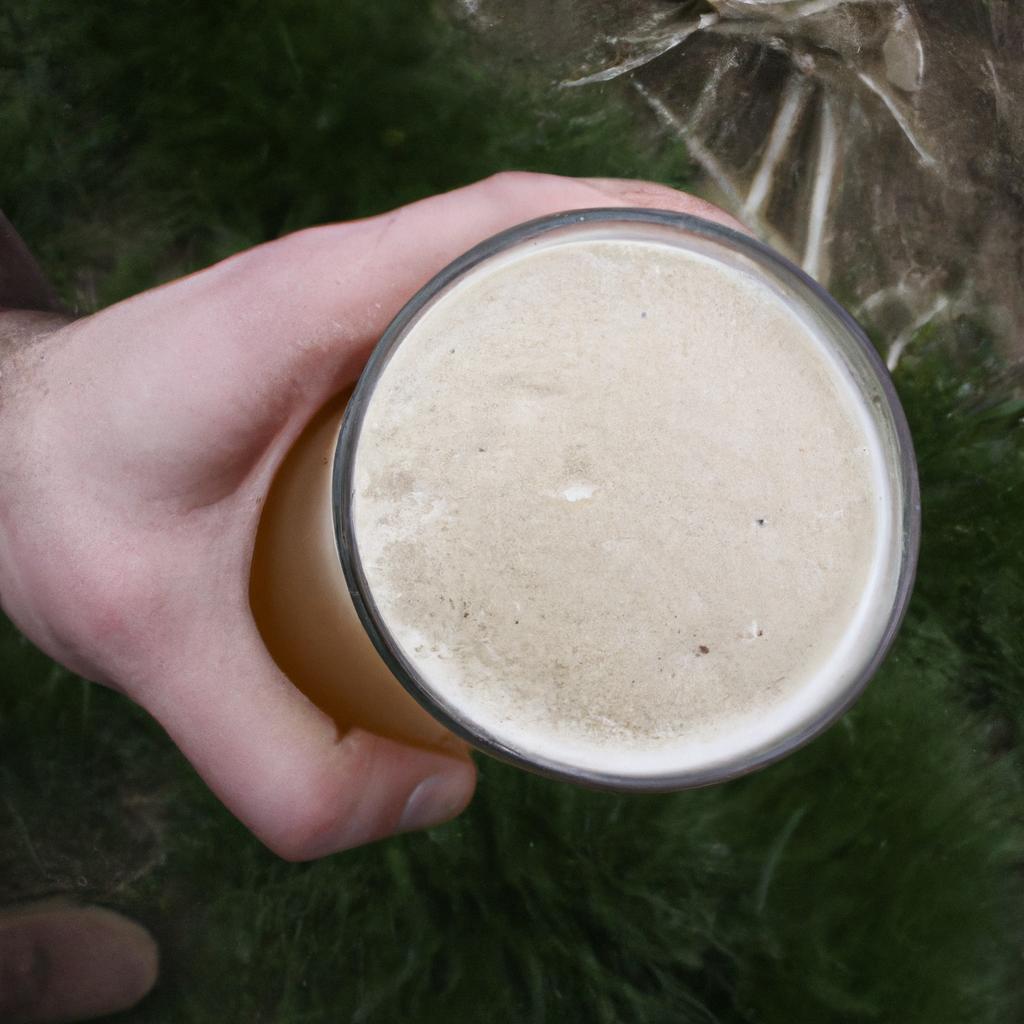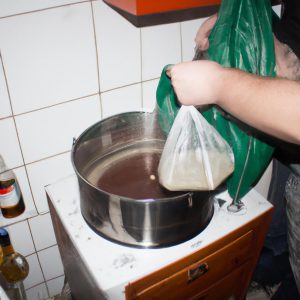Yeast Selection: Beer Reviews>Homebrewing Tips

Yeast selection plays a crucial role in the production of high-quality beer. The choice of yeast strain can greatly impact the flavor, aroma, and overall character of the final product. Homebrewers are often faced with numerous options when it comes to selecting yeast for their brews, each offering unique properties that contribute to different styles and characteristics. For instance, imagine a homebrewer aiming to create a smooth and malty Oktoberfest-style lager. By carefully choosing a suitable yeast strain that complements the desired flavors and fermentation profile, they can enhance the authenticity and enjoyment of their homemade creation.
In recent years, there has been an increasing interest among homebrewing enthusiasts in exploring various yeast strains available on the market. This surge in curiosity stems from a desire to elevate the quality and complexity of homemade beers while experimenting with different styles and flavors. Consequently, understanding how different yeast strains interact with specific beer recipes is essential for achieving consistent results.
This article aims to provide valuable insights into yeast selection by examining its significance within the context of beer reviews and imparting practical homebrewing tips. Through analyzing real-world examples and discussing scientific principles behind yeast behavior during fermentation, this article will empower aspiring brewers with the knowledge required to make informed decisions about which yeast strains to use in their beer recipes.
When selecting a yeast strain for a particular beer style, it is important to consider its fermentation characteristics. Different yeast strains produce varying levels of esters and phenols, which contribute to the aroma and flavor profile of the beer. For example, certain ale yeast strains can produce fruity esters that enhance the complexity of hop-forward beers like IPAs, while others may be better suited for producing clean and crisp lagers.
Another crucial factor to consider is the temperature range at which the yeast strain performs optimally. Yeast activity and fermentation rates are influenced by temperature, and different strains have different temperature ranges in which they thrive. It is essential to choose a yeast strain that can tolerate the desired fermentation temperature for your specific beer recipe.
Furthermore, some yeast strains are known for their attenuation ability, which refers to how well they ferment sugars into alcohol. Strains with high attenuation can yield a drier finish, while those with lower attenuation may leave behind more residual sweetness. Understanding this characteristic is crucial when aiming to achieve a specific level of dryness or sweetness in your beer.
Lastly, it is worth considering whether you want to use liquid or dry yeast. Liquid yeast offers a wide variety of strains with diverse flavors and characteristics but requires proper handling and preparation before pitching into the wort. Dry yeast, on the other hand, is easier to store and use but typically has a more limited selection of strains available.
In conclusion, selecting the right yeast strain plays a vital role in achieving desired flavors, aromas, and overall character in homemade beer. By understanding the fermentation characteristics, temperature range suitability, attenuation ability, and availability of various yeast strains, homebrewers can make informed decisions when choosing which strain to use in their recipes. Experimenting with different yeasts allows brewers to explore new styles while honing their skills and creating unique and flavorful beers.
Understanding Yeast Strains
Imagine you are a homebrewer, eager to perfect your craft and create the best-tasting beer possible. One crucial factor that can make or break your brew is yeast selection. Different yeast strains bring unique characteristics to your beer, influencing its flavor profile, aroma, and even mouthfeel. To truly appreciate the impact of yeast on the final product, let’s explore the intricacies of understanding yeast strains.
Yeast strains can be categorized into two main types: ale yeast and lager yeast. Ale yeast ferments at higher temperatures (between 15-24°C), resulting in beers with robust flavors such as fruity esters and spicy phenols. On the other hand, lager yeast requires lower temperatures (around 7-13°C) for fermentation, leading to clean-tasting beers with fewer esters and a smoother finish. Understanding these distinctions allows brewers to tailor their recipes accordingly.
To further grasp the importance of selecting the right yeast strain, consider these emotional responses evoked by different flavor profiles:
- A rich chocolatey stout conjures feelings of comfort and indulgence.
- The refreshing citrus notes in an American IPA evoke images of sunny days and tropical escapes.
- The delicate floral aromas found in certain Belgian styles transport us to quaint European gardens.
- The crispness of a classic German Pilsner elicits thoughts of tradition and craftsmanship.
Now, let’s take a closer look at how various yeasts contribute to specific beer styles through this three-column table:
| Beer Style | Yeast Strain | Flavor Profile |
|---|---|---|
| Stout | English Ale | Roasty, Chocolatey |
| American IPA | California Ale | Citrusy, Piney |
| Belgian Witbier | Belgian Wheat | Spicy, Fruity |
| German Pilsner | German Lager | Clean, Crisp |
By understanding the characteristics of different yeast strains and their impact on beer style, homebrewers can make informed decisions when selecting yeast for their recipes. Remember that these are just a few examples; there is an extensive range of yeasts available to explore.
As we move forward into the next section about “Factors to Consider When Selecting Yeast,” it becomes evident that making the right yeast selection involves careful consideration of various factors such as fermentation temperature, alcohol tolerance, and desired flavor profile. Each element plays a significant role in creating a successful brew, guiding brewers towards achieving their intended outcome – a deliciously crafted beer.
Factors to Consider When Selecting Yeast
Understanding Yeast Strains and Factors to Consider When Selecting Yeast
In the previous section, we explored the importance of understanding yeast strains in homebrewing. Now, let’s delve into the factors that should be considered when selecting yeast for your brew.
To illustrate these factors, let’s consider a hypothetical case study. Imagine you are a homebrewer aiming to create a crisp and refreshing American Pale Ale (APA). This beer style typically exhibits moderate hop bitterness with balanced malt flavors, making it an ideal choice for those seeking a well-rounded craft beer experience.
When choosing yeast for an APA, there are several key considerations:
- Flavor Profile: The selected yeast strain should complement the desired flavor profile of the APA. Different strains can produce varying levels of fruity esters or spicy phenols, which can significantly impact the overall taste of the finished beer.
- Attenuation: Attenuation refers to how efficiently yeast consumes sugars during fermentation. For an APA, a medium attenuation level is generally preferred to ensure a balance between residual sweetness and dryness.
- Flocculation: Flocculation describes how readily yeast clumps together and settles at the bottom of the fermenter after fermentation is complete. High flocculating yeasts tend to result in clearer beers, while low flocculating yeasts may require additional steps such as cold crashing or fining agents for clarity.
- Temperature Tolerance: It is crucial to select a yeast strain that thrives within your brewing environment’s temperature range. Some strains perform better at higher temperatures, while others excel at lower temperatures; this affects both fermentation speed and flavor development.
Considering these factors helps narrow down potential choices based on their suitability for creating an exceptional APA. To further assist you in making informed decisions about yeast selection, refer to Table 1 below:
Table 1: Recommended Yeast Strains for American Pale Ale
| Yeast Strain | Flavor Profile | Attenuation | Flocculation |
|---|---|---|---|
| US-05 | Clean, Neutral | High | High |
| WLP001 | Crisp, Fruity | Medium | Medium |
| Nottingham | Malty, Slightly Fruity | High | Low-Medium |
| BRY-97 | Citrusy, Floral | High | Medium-High |
By carefully considering these factors and utilizing the data provided in Table 1, you can confidently select a yeast strain that will best suit your desired APA recipe.
Transitioning into the subsequent section on “Top 5 Yeast Strains for Different Beer Styles,” it is essential to explore how various yeast strains contribute to different beer styles’ unique characteristics. Let’s now examine some popular yeast strains and their compatibility with specific beer styles.
Top 5 Yeast Strains for Different Beer Styles
Factors to Consider When Selecting Yeast: A Case Study
To better understand the importance of yeast selection in homebrewing, let’s consider a hypothetical scenario. Imagine you are an avid homebrewer who decides to brew a classic American Pale Ale. You diligently research various recipes and gather all the necessary ingredients. However, when it comes to selecting the yeast strain for fermentation, you find yourself faced with numerous options. This is where understanding factors that influence yeast selection becomes crucial.
When choosing yeast for your beer, there are several key considerations to keep in mind:
-
Beer Style Compatibility: Different styles require specific yeast characteristics to achieve their desired flavors and aromas. For instance, a Belgian Witbier typically calls for a strain that imparts fruity esters and spicy phenols, while a German Hefeweizen relies on strains that produce banana and clove-like flavors.
-
Alcohol Tolerance: It is essential to select a yeast strain capable of fermenting the desired alcohol content in your beer recipe. Failure to do so may result in incomplete fermentation or excessive residual sugars.
-
Temperature Range: Yeasts have optimal temperature ranges for fermentation, and deviating from these ranges can lead to off-flavors or stalled fermentation. Understanding the ideal temperature range for your chosen yeast will help ensure successful fermentation.
-
Flocculation and Attenuation Properties: Flocculation refers to how well the yeast clumps together after fermentation, affecting clarity and sedimentation in the final product. Attenuation measures how effectively yeasts consume sugars during fermentation, impacting both sweetness and dryness levels.
Now let’s examine some popular yeast strains commonly used across different beer styles:
| Yeast Strain | Beer Style | Flavor Profile |
|---|---|---|
| American Ale | American IPA | Clean, crisp, citrusy |
| English Ale | English Bitter | Fruity, malty, with slight toffee notes |
| Bavarian Lager | German Helles | Clean, balanced, subtle maltiness |
| Belgian Abbey Ale | Belgian Dubbel | Spicy phenols, fruity esters, caramel-like sweetness |
Considering these factors and understanding the characteristics of different yeast strains will greatly influence the outcome of your homebrewed beer. By selecting the appropriate yeast strain for a specific style and adhering to proper brewing techniques, you can achieve exceptional results.
In our next section on the importance of proper yeast handling, we will discuss how crucial it is to handle yeast correctly throughout the brewing process to maintain its viability and ensure optimal fermentation.
Importance of Proper Yeast Handling
Yeast Selection: Beer Reviews>Homebrewing Tips
Top 5 Yeast Strains for Different Beer Styles:
In the previous section, we explored the top five yeast strains for different beer styles. Now, let’s delve into the importance of proper yeast handling to ensure a successful fermentation process and enhance the overall quality of your homebrewed beer.
Imagine this scenario: you’ve meticulously crafted a recipe for a hop-forward IPA, carefully selecting all the ingredients to create that perfect balance of bitterness and citrusy aroma. However, if you neglect proper yeast handling, your end product may not live up to its full potential. Just like any living organism, yeast requires specific conditions to thrive and perform optimally during fermentation.
To help guide you in understanding the significance of proper yeast handling, here are some key considerations:
-
Temperature Control:
Maintaining an appropriate temperature throughout the fermentation process is crucial. Too high or too low temperatures can lead to off-flavors or incomplete fermentations. Ensure that your brewing environment provides stable temperatures within the recommended range for each specific strain. -
Oxygen Exposure:
Minimizing oxygen exposure during transfer and pitching is essential as it can result in flavor instability and unwanted oxidation reactions. Always handle your yeast with care and avoid excessive splashing or agitation when adding it to your wort. -
Pitching Rate:
The amount of yeast cells added to your wort (pitching rate) plays a vital role in achieving a healthy fermentation. Under-pitching can cause stressed yeast and sluggish fermentation while over-pitching can lead to off-flavors or reduced ester production. Follow guidelines provided by reputable sources or use online calculators to determine the ideal pitching rate for your desired beer style. -
Sanitation Practices:
Maintaining impeccable sanitation practices cannot be emphasized enough when it comes to yeast handling. Contamination from bacteria or wild yeasts can ruin an entire batch of beer. Clean and sanitize all equipment thoroughly before use, paying particular attention to any item that will come into contact with the yeast.
To illustrate these considerations further, let’s take a look at a comparison table showcasing two different scenarios of yeast handling:
| Scenario | Temperature Control | Oxygen Exposure | Pitching Rate | Sanitation Practices |
|---|---|---|---|---|
| A | Consistently maintained within recommended range for strain | Minimized through careful transfer and pitching techniques | Properly calculated and pitched according to beer style guidelines | Meticulously followed throughout brewing process |
| B | Fluctuated outside optimal range during fermentation | Excessive splashing and agitation when adding yeast | Over-pitched without considering specific beer style recommendations | Inadequate sanitation practices leading to contamination issues |
As evident from this hypothetical example, scenario A demonstrates proper yeast handling practices resulting in a successful fermentation process with desired flavors. On the other hand, scenario B showcases various mishandling aspects which can potentially lead to undesirable off-flavors or even total batch loss.
In summary, understanding and implementing proper yeast handling techniques is vital for homebrewers aiming to create exceptional beers. By controlling temperature, minimizing oxygen exposure, calculating appropriate pitching rates, and maintaining impeccable sanitation practices, you pave the way for healthy fermentations and flavorful end products.
Now that we have explored the significance of proper yeast handling let’s move on to our next topic: Yeast Starter – How to Ensure a Healthy Fermentation.
Yeast Starter: How to Ensure a Healthy Fermentation
Building upon the importance of proper yeast handling, it is crucial for homebrewers to understand the significance of a healthy fermentation process. By ensuring a robust and thriving yeast starter, brewers can enhance their chances of achieving optimal beer quality. Let us explore some key tips on how to ensure a healthy fermentation.
Case Study: Imagine a scenario where a homebrewer decides to use an expired packet of yeast for their latest batch. Despite following all other steps meticulously, they notice a sluggish fermentation and off-flavors in the final product. This case study exemplifies the vital role that yeast selection and handling play in determining the success or failure of one’s brewing endeavors.
To achieve a healthy fermentation and avoid potential issues, consider these essential tips:
- Choose the right yeast strain: Different strains offer unique flavors and characteristics. Research various options available based on your desired beer style to select the most suitable yeast strain.
- Proper rehydration technique: Rehydrating dry yeast correctly before pitching helps activate its viability and vitality. Follow manufacturer guidelines carefully to maximize its effectiveness.
- Control temperature during fermentation: Yeast activity is highly sensitive to temperature fluctuations. Maintain an appropriate range recommended by the selected strain to promote consistent performance.
- Oxygenation management: While oxygen is essential during early stages of fermentation, excessive exposure later on can lead to off-flavors and stunted attenuation. Avoid unnecessary agitation or splashing.
Consider this table showcasing different types of common beer yeasts alongside their flavor profiles:
| Yeast Strain | Flavor Profile |
|---|---|
| Ale | Fruity |
| Lager | Clean |
| Belgian | Spicy |
| Wheat | Clove-like |
By adhering to these best practices, homebrewers can increase their likelihood of achieving successful fermentations with improved taste profiles and overall beer quality.
Understanding how to ensure a healthy fermentation is just the first step in becoming a skilled homebrewer.
Troubleshooting Common Yeast Issues
Yeast Selection: Beer Reviews>Homebrewing Tips
Building upon the importance of a healthy fermentation process, yeast selection plays a crucial role in determining the flavors and characteristics of your homebrewed beer. By carefully choosing the right strain of yeast, you can enhance the overall quality and taste of your brew. In this section, we will explore key considerations for selecting yeast strains and provide useful tips to help you make an informed decision.
Example: Let’s imagine that you are brewing an IPA with hop-forward flavors and aromas. To achieve the desired outcome, it is essential to select a yeast strain that complements these hoppy characteristics rather than overpowering them. Choosing a neutral or slightly fruity yeast strain can allow the hops to shine through while adding subtle complexity to your brew.
To assist you in making an informed decision when selecting a yeast strain, consider the following factors:
- Desired Flavor Profile: Different strains produce varying esters and phenols, which contribute to unique flavor profiles such as fruity, spicy, or malty notes.
- Attenuation Rate: This refers to how well the yeast consumes sugars during fermentation. Higher attenuation results in drier beers with less residual sweetness.
- Flocculation: The ability of yeast cells to clump together and settle at the bottom of the fermenter after fermentation affects clarity and mouthfeel.
- Temperature Tolerance: Some strains perform better at specific temperature ranges, influencing flavor development and fermentation activity.
| Factor | Description |
|---|---|
| Desired Flavor | Choose a yeast strain based on its ability to create flavors that complement your chosen beer style. |
| Attenuation Rate | Consider whether you prefer a dry or sweeter beer; select a yeast strain with an appropriate attenuation rate. |
| Flocculation | Determine if clarity is important; choose a high flocculating strain for clear beer or a low flocculating one for haze. |
| Temperature Range | Ensure the yeast strain’s optimal temperature aligns with your brewing setup to achieve desirable flavors and aromas. |
Incorporating these considerations into your yeast selection process will help you create homebrewed beers that meet your desired flavor profiles. By understanding how different strains contribute to the overall characteristics of your brew, you can tailor your choices to suit specific styles and experiment with new combinations.
Remember, selecting the right yeast is just the beginning of the brewing journey. In our next section on troubleshooting common yeast issues, we will discuss potential problems that may arise during fermentation and provide practical solutions to address them effectively. Stay tuned!



